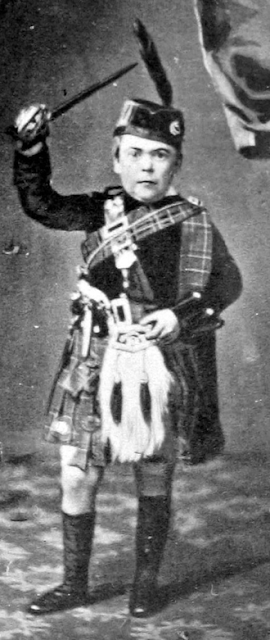I have seen the Asylum they lately have made,
And approve of the plan, but indeed I'm afraid
If they send all the people of reason bereft
To this Bedlam, but few in the town will be left.
For their passions and drink are so terribly strong
That but few here retain all their faculties long.
And with shame I must own, that the females, I think.
Are in general somewhat addicted to drink!
The above was the comic remark of the English poet Thomas Hood during a stay in Dundee in 1815. Although there was recognition that mental illness had to be treated with care there is evidence enough of ill treatment before, during and after its onset. Here's a haunting record of a nameless inhabitant of a mental institution in Dundee in the early 19th century which says something about the conditions in society during his age:
A boy, fifteen years of age, was admitted an inmate of the Dundee Lunatic Asylum, having become imbecile from fright. When twelve years of age he was apprenticed to a light business, and some trifling article being one day missing, he was, along with others, locked up in a dark cellar. The children were much alarmed, and all were let out, with the exception of this poor boy, who was detained until past midnight. He became from this time nervous and melancholy, and sunk into a state of insensibility, from which he will never recover. The missing article was found on the following morning, exculpating the boy from the guilt with which he had been charged.
[On Superstitions Connected With The History and Practice of Medicine and Surgery, Thomas Joseph Pettigrew (London, 1844), p. 100.]
Hundreds of people, nameless or barely remembered now, passed through the doors of asylums, orphanages, institutions for the impoverished and the like over the decades.
Prior to the establishment of separate facilities for those who had psychiatric disorders, those afflicted were confined in a little room in an upper flat of Dundee's Town temporarily before being sent to Montrose Asylum*. According to James Myles (Rambles in Forfarshire (Dundee, 1850), p. 52) at least one of those incarcerated there committed suicide, dashing his brains out against the walls.
Dundee Lunatic Asylum
Dundee's Lunatic Asylum was formed as part of the infirmary in the first decade of the 19th century, funded by voluntary contributions, and formally established in 1820 as a separate entity, with premises in Albert Street. Subscriptions were first raised after a meeting of the infirmary in 1800, with contributions being raised, including £100 from the town magistrates. Building was certainly underway bu 1812.
In 1824 there were upwards of 70 patients in the asylum. Their living conditions were described as being at least humane:
In 1833 it was recorded that almost all patients were usefully occupied. The female patients made clothes for themselves and for the male patients. Male patients were mostly employed weaving cloth for use in the establishment or for sale locally, or picking oakum, plus gardening activities.
Among the surprising visitors to the asylum was the American dwarf and entertainer General Tom Thumb. Rorie reports:
In 1875 the institution became the Dundee Royal Lunatic Asylum. A year previous to that the directors purchased Westfield Farm in Liff to establish a new asylum. The area covered was around 110 acres. Gowrie House and Westgreen were established on the site. The public part of the facilities could accommodate up to 400 patients, while the private asylum (Gowrie House) had room for 62 patients. Dundee District Lunacy Board operated Westgreen from 1903 onward, but Dundee Royal Lunatic Asylum at Gowrie House continued as a separate entity.
In 1959 the District Asylum (Westgreen) and the Royal Asylum (Gowrie House) were amalgamated, and became known as the Dundee Royal Mental Hospital. The Westgreen body became Royal Dundee Liff Hospital in 1963. Following opening of psychiatric wards at Ninewells Hospital in Dundee in 2001, Liff was closed.
None are confined to their apartments, in fine weather they are generally found in the airing grounds, pursuing those avocations and amusements to which they are directed by their former habits and taste. Some are engaged in reading; some in playing on musical instruments; some in drawing; some are employed in manual labour in the garden; here a party is seen at cards; there a couple are intent at backgammon; some females are sewing; some knitting or spinning; some voluntary engage in the work of the house; while it must be added with regret that there are others from whom the eye of the keeper must not wander.[History of the Dundee Royal Lunatic Asylum, Davie Rorie (Dundee, 1912), p. 19.]
In 1833 it was recorded that almost all patients were usefully occupied. The female patients made clothes for themselves and for the male patients. Male patients were mostly employed weaving cloth for use in the establishment or for sale locally, or picking oakum, plus gardening activities.
Among the surprising visitors to the asylum was the American dwarf and entertainer General Tom Thumb. Rorie reports:
This remarkable little Yankee dwarf delighted many of the patients. Some of them thought he was a doll and were anxious to touch him that they might be satisfied whether he was or not.
 |
| Charles Sherwood Stratton (1838 – 1883), 'General Tom Thumb' |
In 1959 the District Asylum (Westgreen) and the Royal Asylum (Gowrie House) were amalgamated, and became known as the Dundee Royal Mental Hospital. The Westgreen body became Royal Dundee Liff Hospital in 1963. Following opening of psychiatric wards at Ninewells Hospital in Dundee in 2001, Liff was closed.
 |
Liff Hospital in the late Victorian era
|


No comments:
Post a Comment